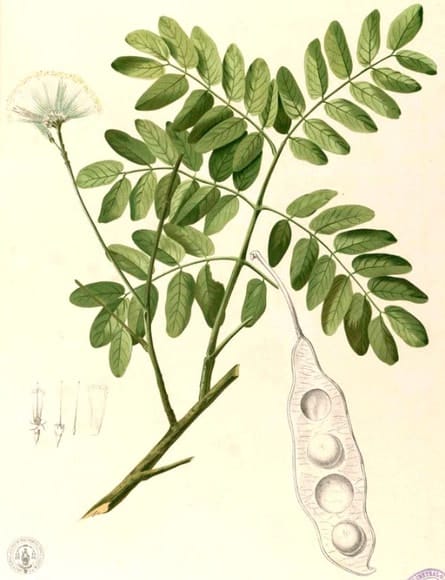Albizia Cortex, He Huan Pi 合欢皮
Silk Tree barkHe Huan Pi (TCM)
Siras (Unani)
Shirisha (Ayurveda)
 Albizia julibrissin (as A. rosea)
Albizia julibrissin (as A. rosea)Revue horticole, serié 4, vol. 42: (1870)
 Albizia lebbeck
Albizia lebbeckM. Blanco, Flora de Filipinas., (1875)
Botanical name:
Albizia spp.
Three species can be noted:
- Albizia julibrissin (Syn: A. nemu, A. rosea, Mimosa julibrissin, M. speciosa, Feuilleea julibrissin, Acacia julibrissin); A. kaikora (TCM)
- A. lebbeck (Siras, Shirisha), used in Unani and Ayurveda, has similar properties, but different uses.
- A. odoritissima, considered synonymous in India
Parts used:
Dried stem-bark
Temperature & Taste:
Neutral (slightly Warm), Sweet
Uses:
1. Calms the Mind and Spirit, Benefits the Heart: (TCM, Ayurveda)
-Irritability, Depression, Emotional Instability, Excess Worry
-Insomnia
-Constrained Emotions
-‘Focuses the Mind, Makes people Happy’ (Shen Nong Ben Cao); this can be classed as an Exhilarant)
-‘Eliminates extremes of the Five Emotions’ (Treasury of Words on the Materia Medica, TCM)
-Migraine (Ayurveda; Charaka)
2. Clears Phlegm, Stops Cough and Wheezing: (Ayurveda)
-Bronchitis, Asthma
-Sinusitis, Rhinitis
3. Moves the Blood, Stops Pain: (TCM)
-pain and swelling from Trauma
-Fractures
-this effect is mild, but good for anxiety or nervousness following Trauma
4. Clears Heat and Toxin, Resolves Abscesses: (TCM, Ayurveda)
-for painful, swollen Boils and Abscesses (internally and topically)
-Lung abscess, it has been used as a stand-alone herb
-Leukoderma, Urticaria, allergic Dermatitis (Ayurveda)
5. Externally:
-Sores, Boils, Abscesses (TCM, Ayurveda)
-Leucoderma, Itching (Ayurveda)
-Hemorrhoids
-strengthens the Teeth and Gums (Ayurveda)
Dose:
6–15 grams
Comment:
Several Indian sources have stated that A. lebbeck and A. julibrissin can be used similarly, and it appears that that latter (Chinese variety) is used synonymously for A. lebbeck in some parts of India. A. odoritissima is also used synonymously in India. Despite the different uses, it has been pointed out that the sedative and tranquilising effects noted in TCM will no doubt have beneficial effects in Bronchitis and Asthma, as used in Ayurveda and Unani. Despite this, the Encyclopedia of TCM (Zhou, Xie & Yan) has given the 3 species quite different uses, this being more related to the differing traditional uses rather than differing effects, in our opinion. We have considered them synonymous.
Substitute:
It has been recommended as a substitute for Tabasheer in Unani texts.
Main Combinations:
1. Anxiety, Mild Depression, Irritability, Albizia He Huan Pi with Polygonum Ye Jiao Teng
2. Insomnia with Heart Yin deficiency, Albizia He Huan Pi with Platycladi Bai Zi Ren
3. Nervous Heart conditions, Albizia bark with Terminalia arjuna (Ayurveda)
4. Trauma, Swelling, Pain, Albizia He Huan Pi with Frankincense, Myrrh
5. Abscesses:
i. Albizia He Huan Pi with Dandelion (Pu Gong Ying), Forsythia (Lian Qiao), Chrysanthemum (Ye Ju Hua)
ii. Albizia bark with Ficus glomerata bark, as a paste topically (Ayurveda)
6. Skin diseases, Albizia bark with Gossypium flowers, Cassia Fistula leaf and Black Nightshade (Charaka, Sushrata),
7. Chronic, non-healing Lung abscess, Albizia He Huan Pi with Ampelopsis Bai Lian
Cautions:
Caution during Pregnancy
